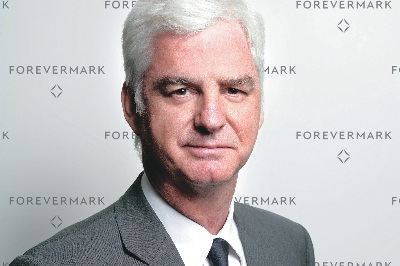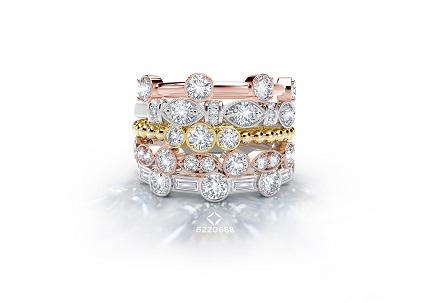Stephen Lussier, CEO, Forevermark

We caught up with Stephen Lussier, CEO, Forevermark, at the 6th Forevermark Forum in Kolkata. Hetalks to Vijetha Rangabashyam about Forevermark’s growth trajectory in India, the average Indian’s sentiment when it comes to buying diamonds, digital disruption, tackling the Gen-Z pop and more.
It has been a rather turbulent couple of years for India; first demonitization, now the GST roll out. How has Forevermark been coping with all this?
Despite all the changes taking place in the Indian environment recently, Forevermark has been performing very well in the country, which reflects our strong global performance.
Earlier this year, we celebrated inscribing our two millionth diamond (which took place in our Surat-based facility) as well as the opening of our 2,000th global retail door, which comes almost eight years after launching the Forevermark brand, and is a fantastic achievement.
In India, Forevermark has been available at the retail level through a shop-inshop model. In m 2017, India is poised to surpass the US to become the second largest market for Forevermark globally, as we expect to more than double our sales volumes in the country. Asia Pacific, Forevermark’s largest market, accounts for 50 per cent of sales volume, with the US and India each accounting for 15 per cent. This year, however, India’s contribution to our global sales will increase to 20-25 per cent. Forevermark jewellery is now available in 200 retail outlets in India, having launched in the Indian market in 2011.
Achieving success is all about maximising current performance. This involves a focus on things such as the in-store experience, increased inventory efficiency, better supplier relationships, enhanced customer service, a better online presence etc. Businesses need to look at undertaking continuous improvement across all aspects of their activity to achieve optimum performance in the here and now. India has witnessed some challenging times with strikes, demonetization, GST and digital disruption; however it is our belief at Forevermark that if you have clarity about the future you can do anything.
How is the current geopolitical scenario in India impacting your business and the diamond industry as a whole?
India remains a key growth market for Forevermark. Last year, our volumes in India stood at 60,000 pieces. This year, we expect this volume to increase to 130,000 pieces, thereby, making India the second largest sales volume generator for Forevermark.
In terms of Indian consumer demand for diamonds, the Indian market has overcome the impacts of demonetisation and is posting a return growth so far this year. This is being driven by positive macro-economic developments, success of government policies and reforms giving consumers greater confidence.
Globally, macro-economic conditions underpinning consumer demand for polished diamonds remain supportive of further, marginal growth in 2017. The extent of global growth will, however, be dependent on a number of macroeconomic factors, including the impact of US and China government policies on exchange rate movements.
In your experience, how different is the sentiment when it comes to buying diamonds in India; as against the US and China?
Diamonds are an emotional purchase and the level of engagement is far greater than it is for almost any other similar purchase. Women connect far more with the stories, emotions and what the product represents. At Forevermark our diamonds are beautiful, rare and responsibly sourced and we believe that each diamond reflects the qualities of the modern woman.
Today’s Indian woman looks to purchase jewellery that reflects her personality. India is a varied country of cultures and each region demands different design aesthetics, for example, in South India, closed setting diamond jewellery is a preference compared to North India where larger diamonds and jewellery is sought after.
In India, buying jewellery has traditionally been a ‘family’ purchase for occasions such as engagements, weddings, child birth, festivals or any momentous occasion. It is also a form of investment to secure the future.
In western countries, a simple piece of jewellery is purchased primarily during engagements or weddings and is worn on a daily basis.
More and more we are seeing an increase in women buying diamond jewellery for themselves. In many markets, it has traditionally been the man buying the diamond as a gift for a woman, but as women have more economic power and a greater role in society, they are buying more frequently for themselves. We are also seeing diamonds start to symbolise a wider range of occasions and emotions than before. Traditionally, diamonds havem been very closely connected with notions of love and commitment, but we are seeing more people buy diamonds as symbols of pride, joy and optimism. And no longer are diamonds just bought for certain occasions such as graduation, engagement and anniversary, but for all significant or happy moments in life.
So, in what way is your campaigning strategy different to appeal to the Indian audience?
The Forevermark promise is that our diamonds are beautiful, rare and responsibly sourced. The beauty of our diamonds is captured and enhanced in the designs of our Forevermark jewellery collections, which we create with the tastes and values of our consumers in mind. We are expanding the use of advanced technology on smaller diamonds and will enable us to bring in smaller daily-wear diamonds to our portfolio in India. Our Forevermark collections such as Cornerstone, Encordia, Millemoi and Capricci exude this subtle elegance and sophistication.
Â
Â

Over the past few years Forevermark has partnered with prominent fashion designers including Tarun Tahiliani, Rohit Bal, Manish Malhotra, Bibhu Mohapatra and recently with Sabyasachi Mukherjee to launch exquisite lines of couture jewellery. We constantly strive to innovate and create various designs to cater to our consumers. We also work with our partners to create exclusive collections available at select stores
As a brand, how has Forevermark dealt with digital disruption?
At Forevermark we have embraced the importance of digital in the consumer’s journey when purchasing one of our diamonds. It is an opportunity for them to find out more about their diamonds’
journey, which is why our consumers are able to register their diamonds using their unique Forevermark inscription to access their diamond’s details. We also look to engage and interact with our consumers in unique ways to share stories, designs and concepts. Digital media actually gives us the opportunity to tell a more engaging emotional story.
Meanwhile, there has also been a change in the way that consumers interact with media. Digital channels have become more important, not only for sales, but particularly for research. More and more people are going online before buying products, so it’s vital that retailers consider the channels they use for getting their messages communicated to consumers. Of course, while many people will always want to see their diamond in person before buying it, online media also offers us great opportunity as it can help us tell our product stories and encourage peer-to-peer sharing of designs and concepts.
As a brand, you are more focused on wearable, lightweight jewellery. Why haven’t you explored the bridal market in India, considering it is such a huge market?
Whilst I have always loved the largerthan- life jewellery that is typically seen on brides in India, Forevermark as a brand is about simpler, more everyday wearable jewellery. The beauty of our diamonds is captured and enhanced in the designs of our Forevermark jewellery collections, which we create with the tastes and values of our consumers in mind and exude subtle elegance and sophistication. As the Indian bridal jewellery landscape shifts, we are seeing more and more brides opting for small and elegant pieces over large trinkets, and this presents a good growth opportunity for Forevermark.
Â

In your opinion, are millenials looking at jewellery as an investment anymore?
While Millennials exhibit different buying behaviours compared to the generations that have come before them, globally they are the largest consumer market for diamond jewellery, so there is clearly a high sense of value placed on diamonds amongst these consumers. A diamond is an emotional purchase. Millennials believe in the stories and emotions that a product offers. Recently, we are seeing the millennial generation express an even stronger preference for branded products than previous generations. We also know that younger consumers seek concepts that offer them individuality, authenticity and responsibility, so it’s important that retailers recognise this trend. This represents a major area of opportunity for a business such as Forevermark, as our brand is ideally positioned to meet these evolving desires.
Coloured stones are becoming a trend now days. More designers are using non-diamond stones in their jewellery and brides are looking at more fun, colourful options – do you think this is a threat to the diamond industry as such?
I don’t think so. While consumer tastes may change depending on trends, diamonds have always been precious and timeless – both carrying people’s emotions and being the ultimate symbol of enduring and everlasting love. At Forevermark, we pride ourselves that not only are our diamonds beautiful and rare, they are responsibly sourced. Less than 1% of the world’s diamonds are eligible to be inscribed as Forevermark – which really gives you this sense of a rare, finite and valued product. Not only are we finding that more and more Indian brides are opting for small and elegant pieces over huge chunky trinkets, but they also prefer to buy natural, high quality diamonds.
Be the first to comment